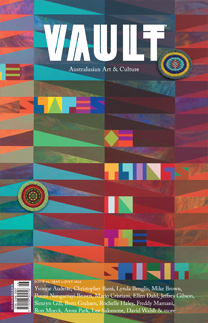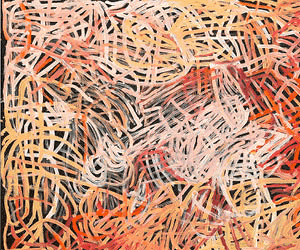Haus Yuriyal:
The House that Eric Bridgeman Built
Eric Bridgeman muses over the conundrum of football codes, living between worlds, and the real question he wants to hear about the kuman paintings.
With a warm, broad smile, Eric Bridgeman welcomes me on the steps of Brisbane’s Milani Gallery in West End, ready to usher me to his studio in the gallery’s residence next door. Inside, the air is heavy with the smell of paint; the space is a veritable cornucopia offering a feast for the eyes. Works rest against the walls and the floor, and in piles. Some of his older works are hung, and the walls of the studio itself seem to have become a canvas for his thoughts and ideas. This symphony of colour, line and form is, I imagine, like walking into Bridgeman’s mind. It is striking that as ‘loud’ as the studio appears, Bridgeman himself possesses a disarming and gentle quietude that easily lulls a fellow traveller into state of repose. After an easy chat, Bridgeman signals he is ready to talk shop.
On the matter of his Papua New Guinea origins, Bridgman shares his maternal clan is from Omdara, Simbu Province, “but due to remoteness, safety, tribal conflict and family presence I decided to base myself in neighbouring Wahgi region in Jiwaka Province where many family members had relocated as a result of marriages, opportunities and tribal conflict in our [original]home base in Simbu”. Now residing part of the year in PNG and the rest in Redcliffe, Brisbane, Bridgeman lives and works between very different worlds. In both, however, he is championing a revitalisation of the traditions of his Yuriyal generation through the shield (kuman) paintings made in collaboration with his clansmen.... Subscribe to read this article in full
























